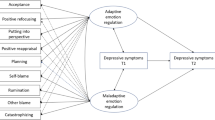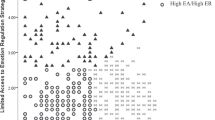Abstract
The current study investigated concurrent and prospective associations between emotion-related constructs and loss of control (LOC) eating in adolescents. Community-based females (N = 588) completed annual self-report assessments of LOC eating, emotional awareness, emotion regulation strategies, and neuroticism from ages 16 to 18 years. Linear regressions and a regression-based multiple mediation model using bootstrapping were computed to examine the relationships among emotion-related constructs and LOC eating frequency. In the concurrent model, age 18 emotional awareness and emotion regulation strategies were associated with age 18 LOC eating, F(6, 416) = 12.11, p < 0.001, accounting for 4.5 % of the variance after controlling for demographics, body mass index, and neuroticism, F change = 10.81, p < 0.001. In the prospective model, age 17 emotional awareness predicted age 18 LOC eating, F(7, 425) = 11.67, p < 0.001, accounting for 1.7 % of unique variance beyond the effects of age 16 LOC eating and age 17 demographics, body mass index, and neuroticism, F change = 4.26, p = 0.015. In the multiple mediation model, age 18 emotion regulation strategies mediated the association between age 17 neuroticism and age 18 LOC eating, indirect effect estimate = 0.003, 95 % confidence interval = 0.001–0.005, after controlling for age 16 LOC eating and age 17 demographics, body mass index, and emotion regulation variables. Results suggest that deficient emotion regulation may contribute to the onset and maintenance of LOC eating in adolescence (although effects were small), and may partially explain the well-established prospective relationship between negative emotionality and later LOC eating. Prevention and early intervention programs should seek to improve adaptive coping in at-risk populations.
Similar content being viewed by others
References
American Psychiatric Association. (2013). Diagnostic and statistical manual of mental disorders (5th ed.). Washington: American Psychiatric Association.
Baron, R. M., & Kenny, D. A. (1986). The moderator-mediator variable distinction in social psychological research: conceptual, strategic and statistical considerations. Journal of Personality and Social Psychology, 51, 1173–1182.
Berg, K. C., & Wonderlich, S. A. (2013). Emerging psychological treatments in the field of eating disorders. Current Psychiatry Reports, 15, 407. doi:10.1007/s11920-013-0407-y.
Brockmeyer, T., Skunde, M., Wu, M., Bresslein, E., Rudofsky, G., Herzog, W., & Friederich, H. C. (2014). Difficulties in emotion regulation across the spectrum of eating disorders. Comprehensive Psychiatry, 55, 565–571. doi:10.1016/j.comppsych.2013.12.001.
Carano, A., De Berardis, D., Gambi, F., Di Paolo, C., Campanella, D., Pelusi, L., & Ferro, F. M. (2006). Alexithymia and body image in adult outpatients with binge eating disorder. International Journal of Eating Disorders, 39, 332–340. doi:10.1002/eat.20238.
Combs, J. L., Pearson, C. M., & Smith, G. T. (2011a). A risk model for preadolescent disordered eating. International Journal of Eating Disorders, 44, 596–604. doi:10.1002/eat.20851.
Combs, J. L., Smith, G. T., & Simmons, J. R. (2011b). Distinctions between two expectancies in the prediction of maladaptive eating behavior. Personality and Individual Differences, 50, 25–30. doi:10.1016/j.paid.2010.08.015.
Corstorphine, E., Mountford, V., Tomlinson, S., Waller, G., & Meyer, C. (2007). Distress tolerance in the eating disorders. Eating Behaviors, 8, 91–97. doi:10.1016/j.eatbeh.2006.02.003.
Czaja, J., Rief, W., & Hilbert, A. (2009). Emotion regulation and binge eating in children. International Journal of Eating Disorders, 42, 356–362. doi:10.1002/eat.20630.
De Los Reyes, A., & Kazdin, A. E. (2005). Informant discrepancies in the assessment of childhood psychopathology: a critical review, theoretical framework, and recommendations for further study. Psychological Bulletin, 131, 483–509. doi:10.1037/0033-2909.131.4.483.
Decaluwe, V., & Braet, C. (2004). Assessment of eating disorder psychopathology in obese children and adolescents: interview versus self-report questionnaire. Behaviour Research and Therapy, 42, 799–811. doi:10.1016/j.brat.2003.07.008.
Dingemans, A. E., Martijn, C., Jansen, A. T., & van Furth, E. F. (2009). The effect of suppressing negative emotions on eating behavior in binge eating disorder. Appetite, 52, 51–57. doi:10.1016/j.appet.2008.08.004.
Elliott, C. A., Tanofsky-Kraff, M., Shomaker, L. B., Columbo, K. M., Wolkoff, L. E., Ranzenhofer, L. M., & Yanovski, J. A. (2010). An examination of the interpersonal model of loss of control eating in children and adolescents. Behaviour Research and Therapy, 48, 424–428. doi:10.1016/j.brat.2009.12.012.
Fischer, S., & Peterson, C. (2015). Dialectical behavior therapy for adolescent binge eating, purging, suicidal behavior, and non-suicidal self-injury: a pilot study. Psychotherapy (Chicago, Ill.), 52, 78–92. doi:10.1037/a0036065.
Fischer, S., Peterson, C. M., & McCarthy, D. (2013). A prospective test of the influence of negative urgency and expectancies on binge eating and purging. Psychology of Addictive Behaviors, 27, 294–300. doi:10.1037/a0029323.
Garner, D. M., Olmsted, M. P., Bohr, Y., & Garfinkel, P. E. (1982). The eating attitudes test: psychometric features and clinical correlates. Psychological Medicine, 12, 871–878. doi:10.1017/S0033291700049163.
Gianini, L. M., White, M. A., & Masheb, R. M. (2013). Eating pathology, emotion regulation, and emotional overeating in obese adults with binge eating disorder. Eating Behaviors, 14, 309–313. doi:10.1016/j.eatbeh.2013.05.008.
Goldschmidt, A. B., Doyle, A. C., & Wilfley, D. E. (2007). Assessment of binge eating in overweight youth using a questionnaire version of the child eating disorder examination with instructions. International Journal of Eating Disorders, 40, 460–467. doi:10.1002/eat.20387.
Goldschmidt, A. B., Aspen, V. P., Sinton, M. M., Tanofsky-Kraff, M., & Wilfley, D. E. (2008a). Disordered eating attitudes and behaviors in overweight youth. Obesity, 16, 257–264. doi:10.1038/oby.2007.48.
Goldschmidt, A. B., Jones, M., Manwaring, J. L., Luce, K. H., Osborne, M. I., Cunning, D., & Taylor, C. B. (2008b). The clinical significance of loss of control over eating in overweight adolescents. International Journal of Eating Disorders, 41, 153–158. doi:10.1002/eat.20481.
Goldschmidt, A. B., Engel, S. G., Wonderlich, S. A., Crosby, R. D., Peterson, C. B., Le Grange, D., & Mitchell, J. E. (2012). Momentary affect surrounding loss of control and overeating in obese adults with and without binge eating disorder. Obesity, 20, 1206–1211. doi:10.1038/oby.2011.286.
Gratz, K. L., & Roemer, L. (2004). Multidimensional assessment of emotion regulation and dysregulation: development, factor structure, and initial validation of the Difficulties in Emotion Regulation Scale. Journal of Psychopathology and Behavioral Assessment, 26, 41–54. doi:10.1007/s10862-008-9102-4.
Gross, J. J., & Barrett, L. F. (2011). Emotion generation and emotion regulation: one or two depends on your point of view. Emotion Review, 3, 8–16. doi:10.1177/1754073910380974.
Haedt-Matt, A. A., & Keel, P. K. (2011). Revisiting the affect regulation model of binge eating: a meta-analysis of studies using ecological momentary assessment. Psychological Bulletin, 137, 660–681. doi:10.1037/a0023660.
Hayes, A. F. (2013). Introduction to mediation, moderation, and conditional process analysis: A regression-based approach. New York: Guilford Press.
John, O. P., & Gross, J. J. (2004). Healthy and unhealthy emotion regulation: personality processes, individual differences, and life span development. Journal of Personality, 72, 1301–1333. doi:10.1111/j.1467-6494.2004.00298.x.
Johnson, W. G., Rohan, K. J., & Kirk, A. A. (2002). Prevalence and correlates of binge eating in white and African American adolescents. Eating Behaviors, 3, 179–189. doi:10.1016/S1471-0153(01)00057-5.
Kelly, N. R., Cotter, E. W., & Mazzeo, S. E. (2014). Examining the role of distress tolerance and negative urgency in binge eating behavior among women. Eating Behaviors, 15, 483–489. doi:10.1016/j.eatbeh.2014.06.012.
Kessler, R. C., Berglund, P. A., Chiu, W. T., Deitz, A. C., Hudson, J. I., Shahly, V., & Xavier, M. (2013). The prevalence and correlates of binge eating disorder in the World Health Organization World Mental Health Surveys. Biological Psychiatry, 73, 904–914. doi:10.1016/j.biopsych.2012.11.020.
Leehr, E. J., Krohmer, K., Schag, K., Dresler, T., Zipfel, S., & Giel, K. E. (2015). Emotion regulation model in binge eating disorder and obesity--a systematic review. Neuroscience and Biobehavioral Reviews, 49, 125–134. doi:10.1016/j.neubiorev.2014.12.008.
Lock, J. (2015). An update on evidence-based psychosocial treatments for eating disorders in children and adolescents. Journal of Clinical Child and Adolescent Psychology, 44, 707–721. doi:10.1080/15374416.2014.971458.
Loeber, R., Stouthamer-Loeber, M., Farrington, D. P., Lahey, B. B., Keenan, K., & White, H. R. (2002). Editorial introduction: three longitudinal studies of children’s development in Pittsburgh: the Developmental Trends Study, the Pittsburgh Youth Study, and the Pittsburgh Girls Study. Criminal Behaviour and Mental Health, 12, 1–23. doi:10.1002/cbm.483.
Markey, M. A., & Vander Wal, J. S. (2007). The role of emotional intelligence and negative affect in bulimic symptomatology. Comprehensive Psychiatry, 48, 458–464. doi:10.1016/j.comppsych.2007.05.006.
McCrae, R. R., & Costa, P. (2010). NEO inventories professional manual. Lutz, FL: Psychological Assessment Resources.
Neumark-Sztainer, D., Wall, M., Larson, N. I., Eisenberg, M. E., & Loth, K. (2011). Dieting and disordered eating behaviors from adolescence to young adulthood: findings from a 10-year longitudinal study. Journal of the American Dietetic Association, 111, 1004–1011. doi:10.1016/j.jada.2011.04.012.
Nevin, J. A., & Grace, R. C. (2000). Behavioral momentum and the law of effect. Behavioral and Brain Sciences, 23, 73–90. doi:10.1017/S0140525X00502404. discussion 90–130.
Pearson, C. M., Combs, J. L., Zapolski, T. C., & Smith, G. T. (2012). A longitudinal transactional risk model for early eating disorder onset. Journal of Abnormal Psychology, 121, 707–718. doi:10.1037/a0027567.
Pearson, C. M., Wonderlich, S. A., & Smith, G. T. (2015). A risk and maintenance model for bulimia nervosa: from impulsive action to compulsive behavior. Psychological Review, 122, 516–535. doi:10.1037/a0039268.
Preacher, K. J., & Hayes, A. F. (2008). Asymptotic and resampling strategies for assessing and comparing indirect effects in multiple mediator models. Behavior Research Methods, 40, 879–891. doi:10.3758/BRM.40.3.879.
Shomaker, L. B., Tanofsky-Kraff, M., Elliott, C., Wolkoff, L. E., Columbo, K. M., Ranzenhofer, L. M., & Yanovski, J. A. (2010). Salience of loss of control for pediatric binge episodes: does size really matter? International Journal of Eating Disorders, 43, 707–716. doi:10.1002/eat.20767.
Stice, E. (2002). Risk and maintenance factors for eating pathology: a meta-analytic review. Psychological Bulletin, 128, 825–848. doi:10.1037/0033-2909.128.5.825.
Svaldi, J., Caffier, D., & Tuschen-Caffier, B. (2010). Emotion suppression but not reappraisal increases desire to binge in women with binge eating disorder. Psychotherapy and Psychosomatics, 79, 188–190. doi:10.1159/000296138.
Svaldi, J., Griepenstroh, J., Tuschen-Caffier, B., & Ehring, T. (2012). Emotion regulation deficits in eating disorders: a marker of eating pathology or general psychopathology? Psychiatry Research, 197, 103–111. doi:10.1016/j.psychres.2011.11.009.
Svaldi, J., Tuschen-Caffier, B., Trentowska, M., Caffier, D., & Naumann, E. (2014). Differential caloric intake in overweight females with and without binge eating: effects of a laboratory-based emotion-regulation training. Behaviour Research and Therapy, 56, 39–46. doi:10.1016/j.brat.2014.02.008.
Swanson, S. A., Horton, N. J., Crosby, R. D., Micali, N., Sonneville, K. R., Eddy, K., & Field, A. E. (2014). A latent class analysis to empirically describe eating disorders through developmental stages. International Journal of Eating Disorders, 47, 762–772. doi:10.1002/eat.22308.
Tanofsky-Kraff, M., Marcus, M. D., Yanovski, S. Z., & Yanovski, J. A. (2008). Loss of control eating disorder in children age 12 years and younger: proposed research criteria. Eating Behaviors, 9, 360–365. doi:10.1016/j.eatbeh.2008.03.002.
Watson, D., & Naragon-Gainey, K. (2014). Personality, emotions, and the emotional disorders. Clinical Psychological Science, 2, 422–442. doi:10.1177/2167702614536162.
Whiteside, U., Chen, E., Neighbors, C., Hunter, D., Lo, T., & Larimer, M. (2007). Difficulties regulating emotions: do binge eaters have fewer strategies to modulate and tolerate negative affect? Eating Behaviors, 8, 162–169. doi:10.1016/j.eatbeh.2006.04.001.
Zeman, J., Cassano, M., Perry-Parrish, C., & Stegall, S. (2006). Emotion regulation in children and adolescents. Journal of Developmental and Behavioral Pediatrics, 27, 155–168. doi:10.1097/00004703-200604000-00014.
Acknowledgments
This research was supported by Grants from the National Institute of Mental Health (MH056630, MH081071, MH101342), the National Institute on Drug Abuse (DA012237), the National Center for Research Resources (KL2-RR025000), the FISA Foundation, and the Falk Fund.
Author information
Authors and Affiliations
Corresponding author
Ethics declarations
Conflict of Interest
The authors declare that they have no conflict of interest.
Ethical Approval
All procedures performed in studies involving human participants were in accordance with the ethical standards of the institutional and/or national research committee and with the 1964 Helsinki declaration and its later amendments or comparable ethical standards.
Informed Consent
Informed consent was obtained from all individual participants included in the study.
Rights and permissions
About this article
Cite this article
Goldschmidt, A.B., Lavender, J.M., Hipwell, A.E. et al. Emotion Regulation and Loss of Control Eating in Community-Based Adolescents. J Abnorm Child Psychol 45, 183–191 (2017). https://doi.org/10.1007/s10802-016-0152-x
Published:
Issue Date:
DOI: https://doi.org/10.1007/s10802-016-0152-x




